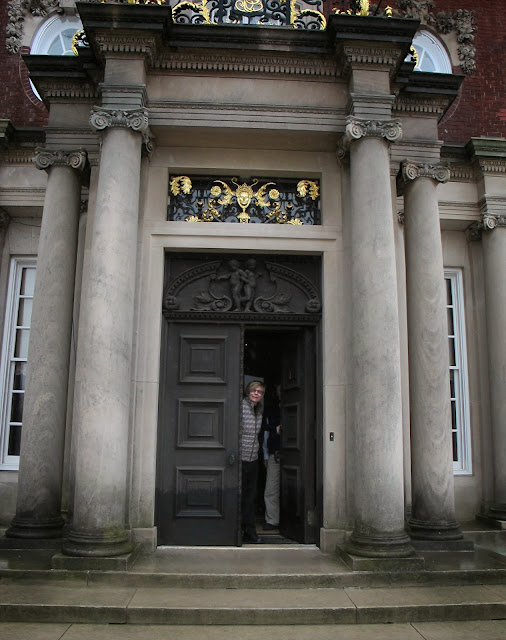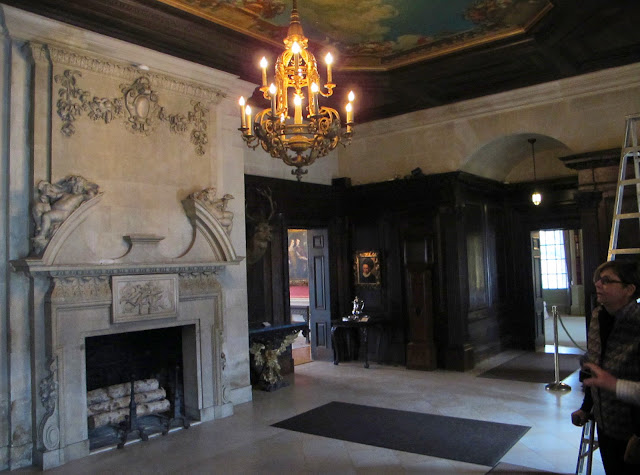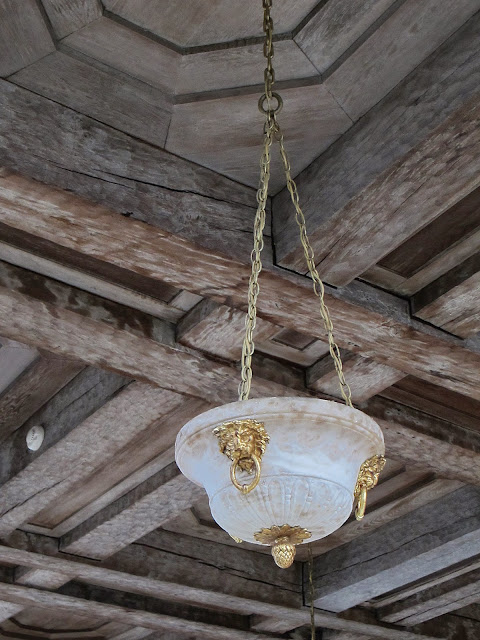There's a great temptation to wallow in superlatives when describing Westbury House, the perfectly exquisite (there I go) Long Island country place completed in 1906 for John ('Jay') Shaffer Phipps (1874-1958) and his wife, the former Margarita ('Dita') Grace (1876-1957). The mists and melting snow on the day of my visit lent an appealing air of otherworldliness to a scholarly mansion and elaborate gardens usually photographed in the blazing sun.
The main gate to Old Westbury Gardens, as the place is called today, originally graced some swell 18th century estate in the English countryside. It is now the ceremonial entrance to the bit-under-200 remaining acres (about 400 in the mid-1930s) of an estate famous for extravagant gardens, temples and pergolas, small romantic lakes and a half-mile long Grand Allee on axis with the mansion itself. These gardens - Walled, Pinetum, Rose, Ghost, Lilac, Primrose, Cottage, Answer, not forgetting the Bluebell Walk - are not just heart-stoppingly beautiful in the soft heat of a Long Island June, but captivating in quite a different way, cloaked in end of winter mists.
The gate in the image below bisects the aforementioned allee. The house lies directly north, hidden in the mist.
In 1911, society architect Horace Trumbauer (1868-1938) added a large service wing, seen below, extending east from the original house.
Westbury House, including its superb gardens, was designed by a socially well connected British aesthete, artist and tastemaker named George Crawley (1864-1926). In 1903, young Jay Phipps, recently married to British shipping heiress Dita Grace, visited his father, Carnegie partner Henry Phipps, at a rented Scottish castle. One assumes they were shooting. Among the party was Mr. Crawley, whom Phipps the elder had recently hired to tweak designs for his new Fifth Avenue house. Crawley and Jay apparently got on like the proverbial house afire, and before you could say "Homestead strike," Crawley agreed to design Jay & Dita's new country place on Long Island. Westbury House is described as being "in the manner" of Charles II, that high living British monarch who, upon the death of sober-sided Oliver Cromwell, gave 17th century England a needed dose of Restoration glamour.
You wanna talk glamour? Here's Jay Phipps astride one of his polo ponies, probably at Westbury, looking every inch the Long Island gentleman. When not playing polo, racing horses or shooting at his Plains, Virginia plantation, Phipps was a lawyer, businessman and director of U.S. Steel, Hanover Bank and W.R. Grace & Co.
Dita Phipps was the daughter of Michael Grace, co-founder with brothers Russel and William, of W.R. Grace & Co., arguably the world's foremost oceangoing passenger and freight line. In 1854 the Grace boys, then still in their twenties, made a killing shipping guano from Peru to North America. By the time Dita married Jay Phipps in 1903, the Graces had become one of the richest families in the world. Uncle William was a two-time mayor of New York, the first Roman Catholic to win that post, and the man who accepted the Statue of Liberty from France. His niece Dita is seen below outside the ballroom at Westbury House, and further below with her son Michael, first as a boy, later as a grown man who followed his father onto the polo fields of Long Island.
The aerial view below was taken in the 1920s, after the Quaker farms of Old Westbury had been transformed into grand estates, but before those estates had been invaded by the aesthetically challenged architecture of Long Island today. Happily, none of the latter is visible from the grounds of the Phipps estate. During its salad days, Old Westbury and towns adjacent contained half a dozen estates belonging to assorted Phippses, Graces and Guests, elegant families interrelated by blood and marriage. Preservation Director Lorraine Gilligan is at the front door, waiting to take me around.
Interestingly, George Crawley was not a professional architect. In lieu of plans, he produced a set of beautiful pictures which then had to be converted into something a builder could follow. Enter Grosvenor Atterbury (1869-1956), an architect of choice for early 20th century country house customers - and, incidentally, the designer of Forest Hills Gardens. Crawley didn't get along too well with Trowbridge and Livingston, the outfit that designed Phipps' father's house in Manhattan. Similar conflicts characterized the job at Westbury House, but you wouldn't guess it from the finished product. The floor plan below, while helpful, is proportionately inaccurate, especially in Trumbauer's 1911 dining room and service suite addition. The prep pantry, for example, is four times the size of the silver room, the corridor to the servants' quarters is a third as wide as it looks, etc., etc.
Crawley had a stable of first class painters and artisans whose work can be seen all over the house. The high style Georgian entrance hall, seen below, is full of beautiful carving by sculptor Derwent Wood and a perspective ceiling (complete with Curious George) by painter A. Duncan Carse.
A short corridor at the western end of the entrance hall, after passing the gents' en route, leads to a library with fine painted paneling. Westbury House was decorated by Sir Charles Carrick Allom (1865-1947), proprietor of the famous firm of White Allom & Company. Clients included Henry Clay Frick, W.R. Hearst, the owners of the new (1931) Waldorf Astoria and the King of England. Ardrossan, the subject of last week's column, was a White Allom job. The portrait above the fireplace is Mrs. Phipps, painted in 1942.
A door on the south wall of the library leads to the drawing room, full of good art, good curtains, a good rug, good sconces, comfortable furniture, a scattering of antiques, a noble fireplace and a pair of very fine Waterford chandeliers - very Charles Allom, all in all. One of the chandeliers is real, the other a reproduction and, short of lowering both and examining them with a spectrograph, I doubt anyone (certainly not me) could tell the difference. The drawing room and library are connected to a large west facing porch. It must be heaven out here in the summer, when the retractable glass walls have disappeared into the floor and the room is filled with potted palms, floral covered wicker and summer breezes.
People with ballrooms didn't usually leave them empty in between dances. The Red Ballroom at Westbury would have been furnished much like the drawing room next door.
Adjoining the ballroom on the east is Mr. Phipps' study. Before the Trumbauer enlargement this was the dining room.
No sooner was it finished than Mr. & Mrs. Phipps began tinkering with their country house, and didn't stop for a quarter of a century. The porch on the west was pushed out and enclosed; the south wall of the enlarged ballroom was crowded onto a former porch. The earliest and biggest change, however, was Trumbauer's dining room and service wing on the east. The dining room we see today is not what Trumbauer, or probably Allom, designed in 1911. To the contrary, it is a reconfigured version of Jay Phipps' father's dining room in New York, designed by George Crawley in 1901 and salvaged prior to the 1927 demolition of Henry Phipps' townhouse at 1063 Fifth Avenue. Jay Phipps' sister Amy Guest saved Crawley's marble staircase from the same house, inserting it, to the dismay of architect Thomas Hastings, into Templeton, her Carrere & Hastings designed house four miles north of her brother's. If you're a regular reader of my column, you've seen that staircase already.
Lorraine is explaining to me how what they call the light court, behind her in the image below, was originally an open porch. The door on the left leads to the new dining room; the one on the right goes to the old dining room, now the study. I'll bet George Crawley intended this vanished porch to balance, at least when seen from certain angles, the one at the other end of the house. Speaking of intentions, I'll also bet Crawley's original plan had the reception room (there is none at present) where the library is, the library in today's drawing room and a drawing room on a reduced footprint on the site of today's ballroom. Admittedly I'm just guessing, but this would be a much more usual arrangement.
What's labeled "children's dining room" on the plan does not speak to the strengths of rejiggered floor plans. The name memorializes the thirty English children who refugeed to Westbury during the blitz. Before Trumbauer built the big addition, a part of this room was undoubtedly a serving pantry. Afterwards, it became part of an oddly inelegant approach route to the dining room. The door to the right of the fireplace leads to offices, pantries, servants' rooms (on this floor and the one above) and a fabulously preserved kitchen in the basement.
The corridor in the image below leads to servants' bedrooms on this floor, and a back stair that connects more servants' rooms on the floor above to a servant hall in the basement below.
Let's head down to the basement kitchen, connected by twin glass doored dumbwaiters to a prep pantry on the main floor. That in turn is connected to a very small serving pantry at the eastern end of the dining room. The basement level is largely below grade. The kitchen and the servant hall, however, have full size windows overlooking a service courtyard.
The former servant hall is now offices; the two-story brick building on the other side of the kitchen court was a laundry house, probably with additional quarters for help.
Time to go upstairs, admire the exceptional wood carving, and consider the second floor plan.
I am told that Mr. P's dressing room and the guestroom to the east of it were originally nurseries. This seems highly unlikely to me. Squalling babies right next door? Nannies on another floor? Guests asked to tiptoe after 8:00? Well, what do I know; I wasn't there. The floor as presently arranged makes more sense.
Mrs. P's delicious little boudoir shares a bath with a corner guestroom called, for obvious reasons, the Adam Room.
The "owners' bedroom" was presumably Mrs. Phipps', whose wonderful en suite bathroom sports silver plated fixtures. I assume her husband slept in "Mr. P's dressing room," the normal arrangement of things in a house like this.
The remaining guestrooms are predictably grand, and the one bath I managed to see was gratifyingly antique.
Here's another reason I love writing this column: "You want to see the roof, John?" That would be a yes. The first view below shows the Trumbauer wing looking east. That little penthouse in the distance contains third floor servants' rooms accessed by the back stair. The laundry house is visible on the other side of the kitchen courtyard.
Now we're looking west towards the balustraded dining room. The little brick dogleg in the center of the frame is the serving pantry, connecting the prep pantry beneath my feet to the dining room.
The third floor appears to be little changed, but was so crammed with storage and afflicted with inevitable leaks that I bowed to my hostess' request and kept photos to a minimum.
And with that, I have finished yet another house.
We're back almost to where we started, at the Grand Allee, but this time looking away from the house. You wouldn't know it, although unfortunately you can hear it, but at the end of this mysterious line of ancient trees are six lanes of roaring traffic on the Jericho Turnpike. Fifteen hundred feet beyond them, past a dozen suburban houses on a subdivision street called Evergreen Drive, are six more lanes on the Northern State Parkway. How close is the nearest subdivision to the left side of the allee? Don't ask.
That something this wonderful could have evaded Long Island's cruel history of postwar suburbanization is a miracle wrought by Mr. & Mrs. Phipps' children. Instead of cashing in, they chose to protect, endow and establish Old Westbury Gardens to maintain their parents' house and grounds for future generations. This extraordinary place is also a venue for paid college internships. Students from around the world study things like plant propagation practices, herbaceous border management, woody plant management and historic landscape preservation for credit towards bachelor's degrees. Old Westbury Gardens is open every weekend from early April until the end of October; the link is www.oldwestburygardens.org.















































































































